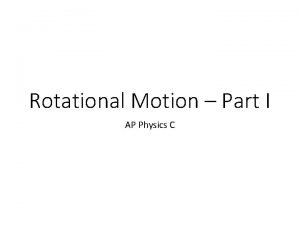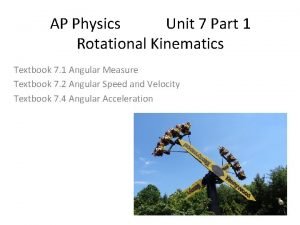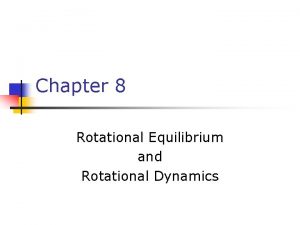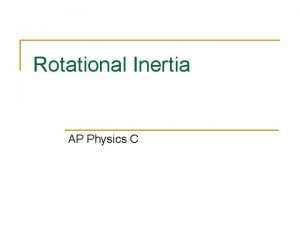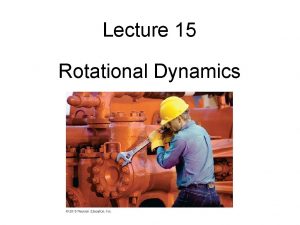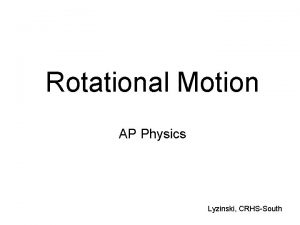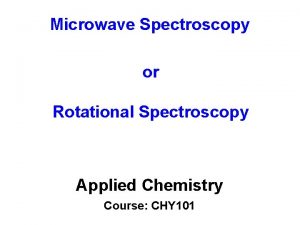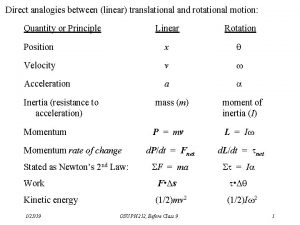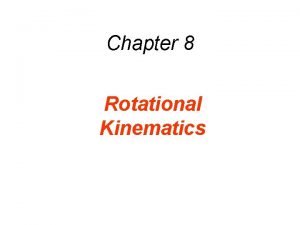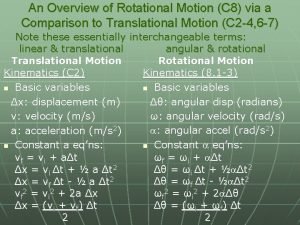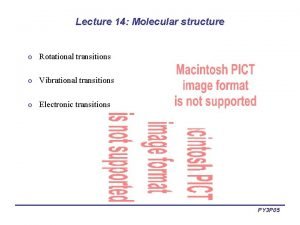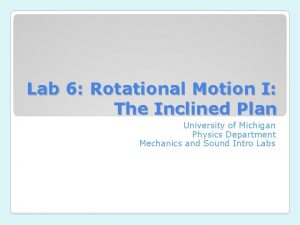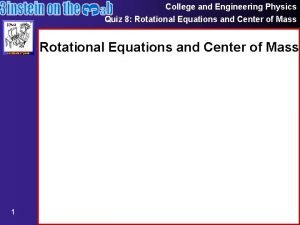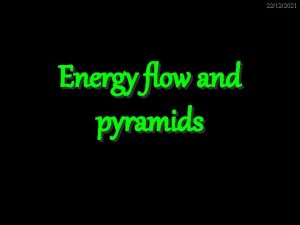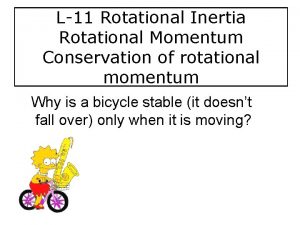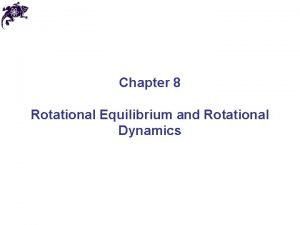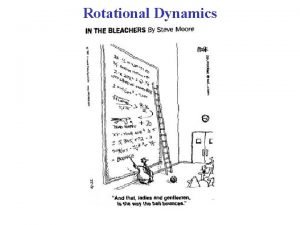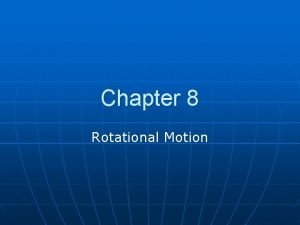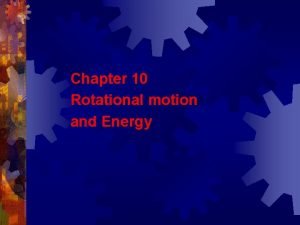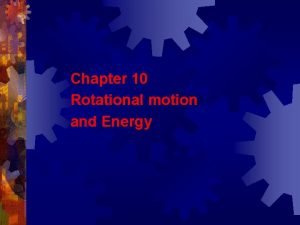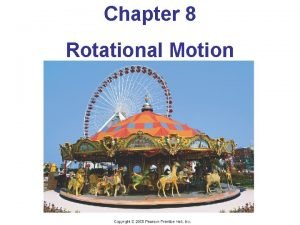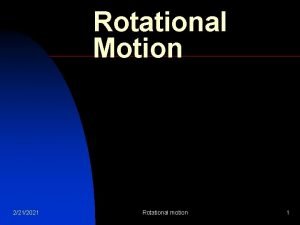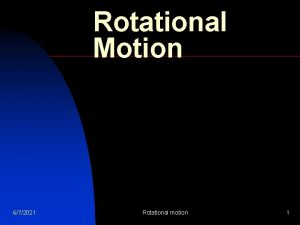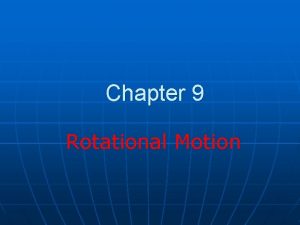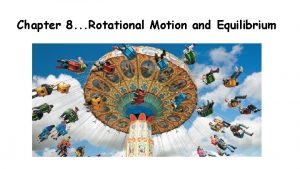22122021 Rotational motion AH Physics Motion in a
















- Slides: 16

22/12/2021 Rotational motion AH Physics

Motion in a circle �Circular or rotational motion is common everywhere from electrons orbiting the nucleus to wheels turning to planets orbiting the sun. �It is important to study rotational motion in the same way that we studied linear motion in National 5 and Higher Physics.

The Circle �The circumference of a circle is 2πr. �The total angle in a circle is……? � What about speed of an object moving in a circular path? �To answer these questions we need to introduce a vital unit in rotational motion…. The Radian.

The Radian Note: The radian is called a dimensionless unit. Since it is the ratio of the arc length to the radius, the units effectively cancel out.

Angular displacement �Angular displacement θ is simply a measure of the total angle that an object has moved through. �It is measured in radians (rad) (remember in a circle there are 2π radians) �Equivalent linear displacement (or distance travelled) and angular displacement of a point moving with rotational motion are linked with this relationship: angular displacement (rad) displacement (m) radius (m) This is because the linear displacement in a circle is 2πr (r is in meters) The angular displacement in a circle is 2π radians.

Examples 1. A bicycle wheel has a radius of 0. 40 m a) Calculate the distance travelled by a point on the rim of the wheel if it turns through (i) 5 revolutions (ii) 22. 5 revolutions b) Calculate the angular displacement of the wheel if a point on the rim of the wheel travels a distance of 100 m. a) (i) 12. 6 m (ii) 56. 5 m (b) 250 radians

Angular velocity (w) �Commonly angular velocity is measured in revolutions per minute (rpm). �This is used for the speed of a car engine, vinyl record turntables, etc �In Physics we have to use radians per second (rad s-1) �To convert revs per minute into radians per second: � 1 revolution = 2π radians 1 minute = 60 seconds Calculate the following in radians per second (rads-1): 45 rpm, 3000 rpm 4. 7 rads-1 314 rads-1

Angular velocity �Angular velocity is the rate of change of angular displacement It is measured in radians per second Tangential speed angular velocity are linked by the following relationship. Radius (m) Tangential speed (ms-1) Angular velocity (rads-1)

Angular velocity & Tangential speed �Two coins are placed on a turntable. One coin is at a distance of 10 cm from the centre. The other coin is at a distance of 25 cm from the centre. �The turntable is rotating at 45 rpm. Determine: a) the angular velocity of the turntable in rad s-1 b) (i) the tangential speed of the coin at a radius of 10 cm (ii) the tangential speed of the coin at a radius of 25 cm a) 4. 7 rad s-1 b) (i) 0. 47 ms-1 (ii) 1. 2 ms-1

Tangential speed of the Earth �The Earth has a radius of 6. 4 x 106 m �The Earth rotates on its own axis once every 24 hours. Determine: a) the angular velocity of the earth in rad s-1 b) the tangential speed of a person standing at the equator. a) 7. 3 x 10 -5 rad s-1 b) 470 ms-1 (This is about 1000 mph !!) What about a person in Edinburgh?

Structured Problems, page 4, Qs 13 -29.

Angular acceleration �Using the same ideas as we did with displacement and velocity: �Angular acceleration is the rate of change of angular velocity α =angular acceleration ω= final angular velocity ω0 = initial angular velocity t = time Linear and angular acceleration are linked by the following relationship: a = tangential acceleration α =angular acceleration r = radius

Rotational equations of motion �Similar to work completed in Higher Physics. Calculations can be carried out using equations of motion for rotational motion.

Example �A thin cord is wound around a pulley with a radius of 7. 5 mm �The cord is pulled and the disc accelerates from rest to 25 rads-1 in 6. 0 seconds. �a) Calculate the angular acceleration of the disc. �b) Calculate the length of string unwound from the pulley �c) Calculate the final tangential speed of a point on the rim of the disc. (10 marks) a) 4. 2 rad s-2 b) 0. 57 m c) 0. 19 ms-1

A thin cord is wound around a pulley with a radius of 7. 5 mm The cord is pulled and the disc accelerates from rest to 25 rads-1 in 6. 0 seconds. �a) Calculate the angular acceleration of the disc. �b) Calculate the length of string unwound from the pulley �c) Calculate the final tangential speed of a point on the rim of the disc.

Structured Problems, page 6, Qs 30 -35.
 Ap physics rotational motion
Ap physics rotational motion Ap physics rotational motion
Ap physics rotational motion Ap physics 1 rotational motion
Ap physics 1 rotational motion Rotational equilibrium and dynamics
Rotational equilibrium and dynamics Rotational equilibrium
Rotational equilibrium Rotational inertia ap physics c
Rotational inertia ap physics c Tangential torque
Tangential torque Translational and rotational motion
Translational and rotational motion Microwave spectroscopy
Microwave spectroscopy Rotational and linear motion analogies
Rotational and linear motion analogies Rotational motion
Rotational motion Definition of irrotational flow
Definition of irrotational flow Translational vs rotational motion
Translational vs rotational motion Rotational motion chemistry
Rotational motion chemistry Rotational motion and the law of gravity
Rotational motion and the law of gravity Rotational dynamics lab
Rotational dynamics lab Torque and rotational motion quiz
Torque and rotational motion quiz
